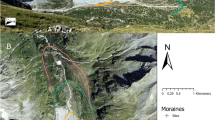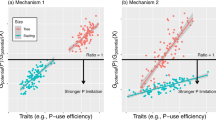Abstract
Warming increases competition among plant species in alpine communities by ameliorating harsh environmental conditions, such as low temperatures. Grazing, as the main human activity, may mitigate the effect of warming, as previously reported. However, it is critical to refine the effects of warming on biotic interactions among species, for example, by taking the competitive ability of species into consideration. Based on a 10-year warming and grazing experiment in a Tibetan alpine meadow, we evaluated interspecific biotic interactions of dominant and subordinate species, using the approach of interspecific spatial associations. Warming significantly increased competition between subordinate and dominant species as well as among subordinate species, but not among dominant species. Moreover, facilitation of dominant-subordinate species also increased under warming. Simulated rotational grazing had similar effects to warming, with increasing interspecific competition. Our results show that, when studying the effects of warming on biotic interactions among species, it is necessary to characterize different species pairs relative to their competitive ability, and that simulated rotational grazing does not mitigate the effects of warming in the long term. Our results also provide evidence that the spatial pattern of species is a critical mechanism in species coexistence.
Similar content being viewed by others
References
Alvarez, L.J., Epstein, H.E., Li, J., and Okin, G.S. (2011). Spatial patterns of grasses and shrubs in an arid grassland environment. Ecosphere 2, art103–30.
Anthelme, F., Cavieres, L.A., and Dangles, O. (2014). Facilitation among plants in alpine environments in the face of climate change. Front Plant Sci 5, 387.
Armas, C., Pugnaire, F.I., and Sala, O.E. (2008). Patch structure dynamics and mechanisms of cyclical succession in a Patagonian steppe (Argentina). J Arid Environ 72, 1552–1561.
Badano, E.I., and Marquet, P.A. (2009). Biogenic habitat creation affects biomass-diversity relationships in plant communities. Perspect Plant Ecol Evol Systat 11, 191–201.
Bagousse-Pinguet, L., Gross, E.M., and Straile, D. (2012). Release from competition and protection determine the outcome of plant interactions along a grazing gradient. Oikos 121, 95–101.
Benot, M.L., Bittebiere, A.K., Ernoult, A., Clément, B., and Mony, C. (2013). Fine-scale spatial patterns in grassland communities depend on species clonal dispersal ability and interactions with neighbours. J Ecol 101, 626–636.
Bolker, B.M., Pacala, S.W., and Neuhauser, C. (2003). Spatial dynamics in model plant communities, what do we really know? Am Nat 162, 135–148.
Brooker, R.W. (2006). Plant-plant interactions and environmental change. New Phytol 171, 271–284.
Brooker, R.W., and Kikvidze, Z. (2008). Importance: an overlooked concept in plant interaction research. J Ecol 96, 703–708.
Callaway, R.M., Brooker, R.W., Choler, P., Kikvidze, Z., Lortie, C.J., Michalet, R., Paolini, L., Pugnaire, F.I., Newingham, B., Aschehoug, E.T., Armas, C., Kikodze, D., and Cook, B.J. (2002). Positive interactions among alpine plants increase with stress. Nature 417, 844–848.
Campbell, B.D., Grime, J.P., Mackey, J.M.L., and Jalili, A. (1991). The quest for a mechanistic understanding of resource competition in plant communities: the role of experiments. Funct Ecol 5, 241–253.
Connell, J.H. (1978). Diversity in tropical rain forests and coral reefs. Science 199, 1302–1310.
Cuesta, B., Villar-Salvador, P., Puértolas, J., Rey Benayas, J.M., and Michalet, R. (2010). Facilitation of Quercus ilex in Mediterranean shrubland is explained by both direct and indirect interactions mediated by herbs. J Ecol 98, 687–696.
Cui, S., Zhu, X., Wang, S., Zhang, Z., Xu, B., Luo, C., Zhao, L., and Zhao, X. (2014). Effects of seasonal grazing on soil respiration in alpine meadow on the Tibetan plateau. Soil Use Manage 30, 435–443.
Damgaard, C. (2010). Intraspecific aggregation does not increase species richness in dune grasslands. J Ecol 98, 1141–1146.
Damgaard, C., Ejrnæs, R., and Stevens, C.J. (2013). Intra-specific spatial aggregation in acidic grasslands, effects of acidification and nitrogen deposition on spatial patterns of plant communities. J Veget Sci 24, 25–32.
De Boeck, H.J., Nijs, I., Lemmens, C.M.H.M., and Ceulemans, R. (2006). Underlying effects of spatial aggregation (clumping) in relationships between plant diversity and resource uptake. Oikos 113, 269–278.
Graff, P., Aguiar, M.R., and Chaneton, E.J. (2007). Shifts in positive and negative plant interactions along a grazing intensity gradient. Ecology 88, 188–199.
Grant, K., Kreyling, J., Heilmeier, H., Beierkuhnlein, C., and Jentsch, A. (2014). Extreme weather events and plant-plant interactions: shifts between competition and facilitation among grassland species in the face of drought and heavy rainfall. Ecol Res 29, 991–1001.
Grime, J.P. (1973). Competitive exclusion in herbaceous vegetation. Nature 242, 344–347.
Grime, J.P. (1998). Benefits of plant diversity to ecosystems: immediate, filter and founder effects. J Ecol 86, 902–910.
Gross, N., Kunstler, G., Liancourt, P., De Bello, F., Suding, K.N., and Lavorel, S. (2009). Linking individual response to biotic interactions with community structure: a trait-based framework. Funct Ecol 23, 1-167–1178.
Kardol, P., Campany, C.E., Souza, L., Norby, R.J., Weltzin, J.F., and Classen, A.T. (2010). Climate change effects on plant biomass alter dominance patterns and community evenness in an experimental old-field ecosystem. Glob Change Biol 16, 2676–2687.
Kimball, B.A., and Conley, M.M. (2009). Infrared heater arrays for warming field plots scaled up to 5-m diameter. Agric For Meteor 149, 721–724.
Klanderud, K. (2005). Climate change effects on species interactions in an alpine plant community. J Ecol 93, 127–137.
Klanderud, K., and Totland, Ø. (2005). Simulated climate change altered dominance hierarchies and diversity of an alpine biodiversity hotspot. Ecology 86, 2047–2054.
Klein, J.A., Harte, J., and Zhao, X.Q. (2004). Experimental warming causes large and rapid species loss, dampened by simulated grazing, on the Tibetan Plateau. Ecol Lett 7, 1170–1179.
Kleijn, D., and Steinger, T. (2002). Contrasting effects of grazing and hay cutting on the spatial and genetic population structure of Veratrum album, an unpalatable, long-lived, clonal plant species. J Ecol 90, 360–370.
Kohyani, P.T., Bossuyt, B., Bonte, D., and Hoffmann, M. (2009). Differential herbivory tolerance of dominant and subordinate plant species along gradients of nutrient availability and competition. Plant Ecol 201, 611–619.
Kunstler, G., Curt, T., Bouchaud, M., and Lepart, J. (2006). Indirect facilitation and competition in tree species colonization of sub-Mediterranean grasslands. J Veget Sci 17, 379–388.
Lamošová, T., Doležal, J., Lanta, V., and Lepš, J. (2010). Spatial pattern affects diversity-productivity relationships in experimental meadow communities. Acta Oecol 36, 325–332.
Law, R., Illian, J., Burslem, D.F.R.P., Gratzer, G., Gunatilleke, C.V.S., and Gunatilleke, I.A.U.N. (2009). Ecological information from spatial patterns of plants: insights from point process theory. J Ecol 97, 616–628.
Liancourt, P., Callaway, R.M., and Michalet, R. (2005). Stress tolerance and competitive-response ability determine the outcome of biotic interactions. Ecology 86, 1611–1618.
Lortie, C.J., Brooker, R.W., Choler, P., Kikvidze, Z., Michalet, R., Pugnaire, F.I., and Callaway, R.M. (2004). Rethinking plant community theory. Oikos 107, 433–438.
Mariotte, P., Buttler, A., Johnson, D., Thébault, A., and Vandenberghe, C. (2012). Exclusion of root competition increases competitive abilities of subordinate plant species through root–shoot interactions. J Veget Sci 23, 1148–1158.
Nyakatya, M.J., and McGeoch, M.A. (2008). Temperature variation across Marion Island associated with a keystone plant species (Azorella selago Hook. (Apiaceae)). Polar Biol 31, 139–151.
Olsen, S.L., and Klanderud, K. (2014). Biotic interactions limit species richness in an alpine plant community, especially under experimental warming. Oikos 123, 71–78.
Perry, G.L.W., Enright, N.J., Miller, B.P., and Lamont, B.B. (2008). Spatial patterns in species-rich sclerophyll shrublands of southwestern Australia. J Veget Sci 19, 705–716.
Porensky, L.M., Vaughn, K.J., and Young, T.P. (2011). Can initial intraspecific spatial aggregation increase multi-year coexistence by creating temporal priority? Ecol Appl 22, 927–936.
Post, E., and Pedersen, C. (2008). Opposing plant community responses to warming with and without herbivores. Proc Natl Acad Sci USA 105, 12353–12358.
Purves, D.W., and Law, R. (2002). Fine-scale spatial structure in a grassland community: quantifying the plant’s-eye view. J Ecol 90, 121–129.
Rayburn, A.P., and Monaco, T.A. (2011). Linking plant spatial patterns and ecological processes in grazed Great Basin plant communities. Rangeland Ecol Manage 64, 276–282.
Reitalu, T., Prentice, H.C., Sykes, M.T., Lonn, M., Johansson, L.J., and Hall, K. (2008). Plant species segregation on different spatial scales in semi-natural grasslands. J Veget Sci 19, 407–416.
Ripley, B.D. (1977). Modelling spatial patterns. J Royal Statist Society 39, 172–212.
Ripley, B.D. (1988). Statistical Inference for Spatial Processes. Cambridge: Cambridge University Press.
Schöb, C., Kammer, P.M., and Kikvidze, Z. (2012). Combining observational and experimental methods in plant-plant interaction research. Plant Ecol Diver 5, 27–36.
Schöb, C., Armas, C., and Pugnaire, F.I. (2013). Direct and indirect interactions co-determine species composition in nurse plant systems. Oikos 122, 1371–1379.
Seidler, T.G., and Plotkin, J.B. (2006). Seed dispersal and spatial pattern in tropical trees. PLoS Biol 4, e344.
Shi, Z., Sherry, R., Xu, X., Hararuk, O., Souza, L., Jiang, L., Xia, J., Liang, J., Luo, Y., and Bardgett, R. (2015). Evidence for long-term shift in plant community composition under decadal experimental warming. J Ecol 103, 1131–1140.
Silvertown, J., Lines, C.E.M., and Dale, M.P. (1994). Spatial competition between grasses—rates of mutual invasion between four species and the interaction with grazing. J Ecol 82, 31–38.
Stoll, P., and Bergius, E. (2005). Pattern and process: competition causes regular spacing of individuals within plant populations. J Ecol 93, 395–403.
Stoll, P., and Prati, D. (2001). Intraspecific aggregation alters competitive interactions in experimental plant communities. Ecology 82, 319–327.
Turnbull, L.A., Coomes, D.A., Purves, D.W., and Rees, M. (2007). How spatial structure alters population and community dynamics in a natural plant community. J Ecol 95, 79–89.
Verwijmeren, M., Rietkerk, M., Bautista, S., Mayor, A.G., Wassen, M.J., and Smit, C. (2014). Drought and grazing combined: contrasting shifts in plant interactions at species pair and community level. J Arid Environ 111, 53–60.
Wang, S., Duan, J., Xu, G., Wang, Y., Zhang, Z., Rui, Y., Luo, C., Xu, B., Zhu, X., Chang, X., Cui, X., Niu, H., Zhao, X., and Wang, W. (2012). Effects of warming and grazing on soil N availability, species composition, and ANPP in an alpine meadow. Ecology 93, 2365–2376.
Wang, Y., Chu, C., Maestre, F.T., and Wang, G. (2008). On the relevance of facilitation in alpine meadow communities: an experimental assessment with multiple species differing in their ecological optimum. Acta Oecol 33, 108–113.
White, S.R., Bork, E.W., and Cahill Jr., J.F. (2014). Direct and indirect drivers of plant diversity responses to climate and clipping across northern temperate grassland. Ecology 95, 3093–3103.
Wiegand, T., and A. Moloney, K. (2004). Rings, circles, and null-models for point pattern analysis in ecology. Oikos 104, 209–229.
Zhu, J., Zhang, Y., and Wang, W. (2016). Interactions between warming and soil moisture increase overlap in reproductive phenology among species in an alpine meadow. Biol Lett 12, 20150749.
Zhu, X., Luo, C., Wang, S., Zhang, Z., Cui, S., Bao, X., Jiang, L., Li, Y., Li, X., Wang, Q., and Zhou, Y. (2015). Effects of warming, grazing/cutting and nitrogen fertilization on greenhouse gas fluxes during growing seasons in an alpine meadow on the Tibetan Plateau. Agric For Meteor 214–215, 506–514.
Zunzunegui, M., Esquivias, M.P., Oppo, F., and Gallego-Fernández, J.B. (2012). Interspecific competition and livestock disturbance control the spatial patterns of two coastal dune shrubs. Plant Soil 354, 299–309.
Acknowledgements
We are grateful to Dr. Andreas Wilkes for polishing this manuscript, especially the grammar. This work was supported by the National Natural Science Foundation of China (41230750, 31402121), the National Basic Research Program of China (2013CB956000), the National Key Research and Development Program of China (2016YFC0501802) and the China Postdoctoral Science Foundation (2013M541050).
Author information
Authors and Affiliations
Corresponding author
Electronic supplementary material
Rights and permissions
About this article
Cite this article
Li, X., Zhu, X., Wang, S. et al. Responses of biotic interactions of dominant and subordinate species to decadal warming and simulated rotational grazing in Tibetan alpine meadow. Sci. China Life Sci. 61, 849–859 (2018). https://doi.org/10.1007/s11427-017-9226-4
Received:
Accepted:
Published:
Issue Date:
DOI: https://doi.org/10.1007/s11427-017-9226-4




